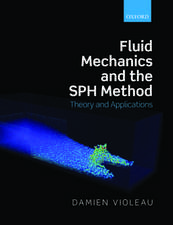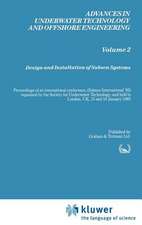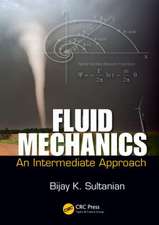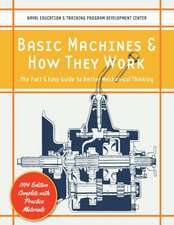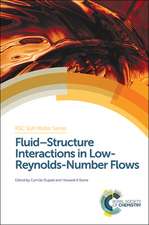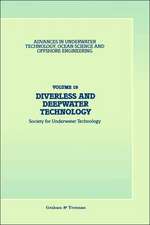Submersible Technology: Adapting to Change: Proceedings of an international conference (’SUBTECH ‘87— Adapting to Change’) organized jointly by the Association of Offshore Diving Contractors and the Society for Underwater Technology, and held Aberdeen, UK, 10–12 November 1987: Advances in Underwater Technology, Ocean Science and Offshore Engineering, cartea 14
Autor Society for Underwater Technology (SUT)en Limba Engleză Paperback – 14 dec 2011
Din seria Advances in Underwater Technology, Ocean Science and Offshore Engineering
- 24%
 Preț: 792.71 lei
Preț: 792.71 lei -
 Preț: 380.84 lei
Preț: 380.84 lei - 15%
 Preț: 641.03 lei
Preț: 641.03 lei - 18%
 Preț: 948.92 lei
Preț: 948.92 lei - 18%
 Preț: 1226.73 lei
Preț: 1226.73 lei - 18%
 Preț: 947.98 lei
Preț: 947.98 lei - 18%
 Preț: 1224.18 lei
Preț: 1224.18 lei -
 Preț: 397.16 lei
Preț: 397.16 lei - 15%
 Preț: 639.25 lei
Preț: 639.25 lei - 18%
 Preț: 1225.31 lei
Preț: 1225.31 lei - 18%
 Preț: 944.19 lei
Preț: 944.19 lei - 18%
 Preț: 1548.44 lei
Preț: 1548.44 lei - 15%
 Preț: 640.37 lei
Preț: 640.37 lei - 18%
 Preț: 949.73 lei
Preț: 949.73 lei - 18%
 Preț: 1223.43 lei
Preț: 1223.43 lei - 15%
 Preț: 645.14 lei
Preț: 645.14 lei - 15%
 Preț: 642.83 lei
Preț: 642.83 lei - 18%
 Preț: 957.62 lei
Preț: 957.62 lei -
 Preț: 392.21 lei
Preț: 392.21 lei - 18%
 Preț: 1260.20 lei
Preț: 1260.20 lei - 18%
 Preț: 954.45 lei
Preț: 954.45 lei -
 Preț: 394.71 lei
Preț: 394.71 lei - 15%
 Preț: 635.01 lei
Preț: 635.01 lei - 15%
 Preț: 697.47 lei
Preț: 697.47 lei - 18%
 Preț: 1223.25 lei
Preț: 1223.25 lei - 15%
 Preț: 638.57 lei
Preț: 638.57 lei - 18%
 Preț: 949.73 lei
Preț: 949.73 lei - 18%
 Preț: 1239.99 lei
Preț: 1239.99 lei - 15%
 Preț: 642.03 lei
Preț: 642.03 lei - 18%
 Preț: 1223.74 lei
Preț: 1223.74 lei
Preț: 642.18 lei
Preț vechi: 755.51 lei
-15% Nou
Puncte Express: 963
Preț estimativ în valută:
122.88€ • 128.64$ • 101.68£
122.88€ • 128.64$ • 101.68£
Carte tipărită la comandă
Livrare economică 05-19 aprilie
Preluare comenzi: 021 569.72.76
Specificații
ISBN-13: 9789401070782
ISBN-10: 9401070784
Pagini: 348
Ilustrații: 328 p.
Dimensiuni: 152 x 229 x 18 mm
Greutate: 0.47 kg
Ediția:Softcover reprint of the original 1st ed. 1988
Editura: SPRINGER NETHERLANDS
Colecția Springer
Seria Advances in Underwater Technology, Ocean Science and Offshore Engineering
Locul publicării:Dordrecht, Netherlands
ISBN-10: 9401070784
Pagini: 348
Ilustrații: 328 p.
Dimensiuni: 152 x 229 x 18 mm
Greutate: 0.47 kg
Ediția:Softcover reprint of the original 1st ed. 1988
Editura: SPRINGER NETHERLANDS
Colecția Springer
Seria Advances in Underwater Technology, Ocean Science and Offshore Engineering
Locul publicării:Dordrecht, Netherlands
Public țintă
ResearchCuprins
I An Overview of R & D, Past, Present and Future.- 1 Sources of funding for research and development in oil and gas technology.- 2 The funding of the Hydra-Lok swage pile connection development.- 3 The drill support tooling module project.- II Reassessment of Standards and Operating Practices.- 4 Review of standards, codes, requirements and regulations—their impact on underwater projects.- 5 Standardization—Norwegian experience by Nifo—Norsk Industriforening for Oljeselskap.- 6 Code of practice for the safe and efficient operation of remotely operated vehicles.- 7 Adapting ROV operations procedures to today’s market.- 8 Using project management as a tool—a necessity in today’s underwater contracting industry.- 9 The CSWIP scheme: a personal view from the Chairman of the Board.- III Saturation Diving.- 10 Higher efficiency through improved diver transportation.- 11 Standards for underwater breathing apparatus.- 12 Monitoring of bacterial status and antibacterial cleaning of saturation diving systems.- 13 HYDRA 8: Pre-commercial hydrogen diving project.- 14 Diver selection for deep dives (below 300 msw).- 15 Saturation diving: diving deeper than 300m.- IV Diving Shallower Than 50m.- 16 Mathematical modeling of tissue bubble dynamics during decompression.- 17 An evaluation of automatic recording of commercial air-diving data.- 18 Civil engineering working practices and standards.- 19 The future of diver training.- 20 Decompression sickness in commercial air divers. The present status of the Shields/Lee report.- 21 Clinical presentations and significance of decompresssion sickness: an analysis of incidents from commercial diving operations 1977–87.- V Developments in Underwater Intervention(Including Robotic Systems).- 22 Design installation and operation ofan ROV- operated subsea production system in 450 msw.- 23 The role of two new autonomous diving systems in underwater intervention.- 24 Wellman: the subsea intervention system.- 25 An overview of current projects in the field of diverless subsea production systems.- 26 Advanced robotics under water: the DTI initiative.- 27 New developments in flooded member detection.- 28 Progress of automation in remote intervention tasks.- 29 Operational automatic hyperbaric welding.- VI Diversification and Innovation—Adapting to Change.- 30 Resources from the sea programme—a technical challenge.- 31 The return of the manned submersible—a new dawn?.- 32 Seabed contact vehicles.- 33 Diversification and innovation: adapting to change—or the view of one small business.- 34 University/Industry/Government Interfaces—Joint R & D Projects—Do They Work?.

